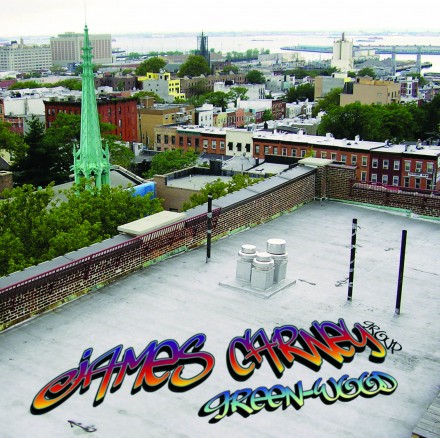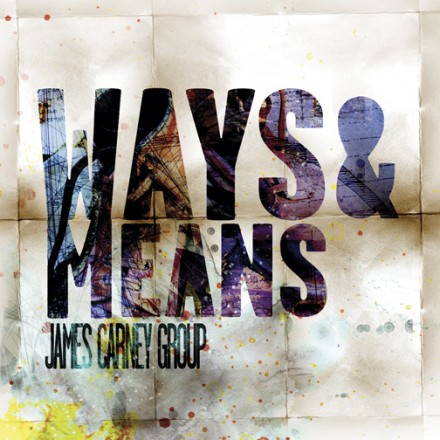James Carney Group
Green-Wood
SGL SA1566-2****1/2 (music and sound) “…a talent-laden septet…a fresh, engaging, and intellectually challenging mix of modern-creative and avant jazz…an aural feast in both stereo and five-channel.”
— Greg Cahill, The Absolute Sound
Winner of the 1999 Thelonious Monk International Jazz Composers Award and the LA Weekly “best jazz artist” award in 2002, James Carney moved from LA to NYC in 2004 and proceeded to put together his dream group featuring a 4-horn frontline: two old friends from his student days at CalArts, Peter Epstein and Ralph Alessi, and new acquaintances Tony Malaby and Josh Roseman. The music he’s given this starry band of improvisers to interpret is beautifully crafted and intensely grooving in various feels, from second line and funk to 6/4 and complex time signatures. Inspired by the whole tradition, Carney’s aesthetic unites the jazz mainstream and avant-garde, blending musical derring-do with a post-bop-meets-chamber-music-and-rock lyricism. His guys deliver with individuality and relish, while the hi-res recording and a cool surround mix make the most of ear-catching voicings, timbres and textures.
Carney comes to his eclecticism naturally. He’s been a high school tuba player, professional bar band keyboardist, and avid student of jazz and world music at CalArts, and he spent 14 years working in the IMAX film world, working his way up from sound effects and music editor to resident composer while leading jazz combos around town and occasional tours. Between 1994 and 2002 he produced and released three CDs on his own label, recording them at high-end LA studios and garnering considerable critical praise in the process (All Music Guide called him “one of the brightest lights on the new jazz scene”). Still, it’s interesting to consider the breadth of the influences he cites: “I could point to Hindemith, Steve Reich, Peter Frampton, Rush, Bill Monroe, Henry Threadgill, Conlon Nancarrow, Keith Emerson, War and Stevie Wonder too, when I listen to this recording. They’re all in there, in assimilated and abstracted ways…. I’ve just tried to find ways to make these different styles work together in my own little world, because I always got the spine tingle effect from lots of different places – Shostakovich, Zeppelin, Charlie Parker – and when I began writing my own music I had an instinctual desire to make it inclusive of everything I ever loved.”
Carney’s compositional process is somewhat unusual as well. Generally he composes everything in his head before writing it down: “I just think it’s easier to change and develop something to its fullest if none of it is already committed to paper….I work out everything in a sort of democratic process along the way – melodies, bass lines, chords, and the voice-leading over the form are all considered at every step, and I’ve found that this approach has proven itself to yield music that has the most organic flow, with the greatest sense of natural cadence.”
“I approach composition as pure improvisation, and vice versa. When I write a piece of music, I want the process to feel as if I’m working out the most perfect, insurmountable, ultimate and unbeatable improvised solo over whatever is being implied by the bass line and accompanying harmonic movement. And often I think a lot about pure bebop, because bebop did that and what it continues to do as a concept is to give a horizontal, linear shape that can really spell out the harmony through the melody; it actually does both things simultaneously, and so to me, the best bebop has always functioned as a model of melodic perfection…..It gets crazy, because I can spend days trying out tons of different single-note melody lines over the same several measures of voice-led chord changes, and it’s that relentless exploration that eventually yields something that I think works best.”
It’s obvious both from his words and his music that Carney’s enthusiasm and energy is tempered by great thoughtfulness and reverence for the artform: “There’s just so much beauty, uncertainty and mystery involved; where emotions and spirituality, new discovery and the craft all converge, and it’s an unbelievable feeling to witness it emanating from within.”
“There are many brilliant young pianists in jazz today, and many have experimented with electric/acoustic approaches to the new century’s music. Jason Moran, Uri Caine, Matthew Shipp, and Brad Mehldau are just four names. But James Carney deserves to be squarely among them. His tidal wave of a new album, Green-Wood, is a minor masterpiece if not even greater than that. Its melodies, grooves, and bravery should easily buoy the music into tomorrow.” – Will Layman, PopMatters.com

